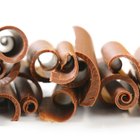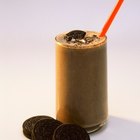
Remains/iStock/Getty Images
For many people, chocolate is both comfort and nemesis – they reach for it when they want a hit of sweet nurture and they swear off it each time they step on the scales. But chocolate has significant healthy properties as well as those unhappy calories. When you understand how chocolate affects your brain – real chocolate with a high percentage of cocoa solids, not cloyingly sweet chocolate with a great deal of added sugar and fat besides the natural cocoa butter – you can enjoy it strategically for emotional and physical benefits.
Stimulation
The cacao plant is scientifically named after theobromine, a stimulant that affects the central nervous system in similar ways to caffeine, but much milder. However, theobromine is present in cacao in much higher amounts than caffeine. Depending on the degree of processing and the cacao solids still present in the chocolate, theobromine can affect energy levels. The average cup of hot cocoa, according to Oregon State University College of Health and Human Sciences, contains 200 milligrams of theobromine but only 10 milligrams of caffeine. A small candy bar, on average, has 155 milligrams of theobromine and just 12 milligrams of caffeine.
Alertness
Caffeine is an ingredient in the cocoa plant from which chocolate is made. Caffeine is immediately absorbed and goes directly to the brain once food or beverages containing it are consumed. The stimulant properties of caffeine increase alertness – the main reason coffee is widely considered a temporary antidote to fatigue. But an excess of caffeine can speed up your heart rate and contribute to a spike in anxiety or depression. Chocolate is not likely to have such an exaggerated effect on your nerves, though. The caffeine in an 8-ounce cup of coffee, according to Brown University Health Education Department, is 85 milligrams. An ounce of semisweet dark chocolate contains only 20 milligrams of caffeine.
Happiness or Headache
Chocolate contains an amino acid from which dopamine is derived. Dopamine is a neurotransmitter that conducts signals between the brain’s nerve cells. It is considered a source for feelings of happiness and pleasure but it can contribute to conditions that trigger migraines in some people. According to Harvard Medical School, the cocktail of amino acids in cacao causes complex reactions in the central nervous system that are still under study.
Mood
Chocolate is really good for your mood. It contains phenylethylamine, a mood elevator that makes your pulse race slightly, and raises blood-glucose levels. Add to that the pleasurable sensation of chocolate melting in your mouth due to the melting point of cocoa butter being just below the temperature of the human body, and it’s easy to understand some of chocolate’s appeal. Anandamides, chemicals that release endorphins, enhance chocolate’s reputation as a feel-good sweet.
Related Articles

Bad Effects of Chocolate

What Vitamin Are You Missing If You ...

Stimulants in Chocolate That Are not ...

The Antioxidant Levels of Cacao

Types of Healthy Dark Chocolate

Chocolate and Vitamins

FDA Standards of Chocolate Identity

The History of Caramel Candy

How to Remove Chocolate Stains From ...

Foods Containing Theobromine

Nutrition in Carob Vs. Chocolate

How Many Types of Chocolate Are There?

The Carbohydrates in Chocolate

How to Substitute Cocoa Powder for ...

Can You Make Chocolate Ganache Frosting ...

Cocoa Butter Nutrition

Which Country Produces the Most ...

How to Melt Hershey's Chocolate

How Much Caffeine Is in Tootsie Rolls?

Chocolate Milk and Weight Loss
References
Writer Bio
Benna Crawford has been a journalist and New York-based writer since 1997. Her work has appeared in USA Today, the San Francisco Chronicle, The New York Times, and in professional journals and trade publications. Crawford has a degree in theater, is a certified Prana Yoga instructor, and writes about fitness, performing and decorative arts, culture, sports, business and education .
Photo Credits
Remains/iStock/Getty Images